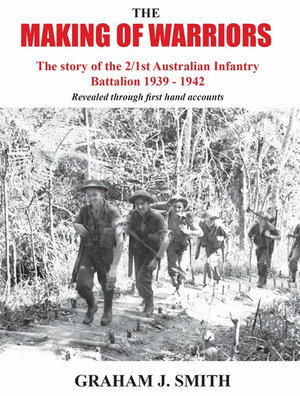Military history continues to be the beneficiary from descendants of those involved in both World Wars researching their exploits, only to expand their research into a work on the unit in which the relative served.

The story of the 2/1st Infantry Battalion The City of Sydney Regiment 1939-1942
Graham J Smith Dural, NSW: Rosenberg Publishing, 2020.
Paperback 248pp RRP $34.95
Graeme Smith spent five years examining the background of Sergeant Jack Ledden MM (pictured on the cover) and has produced a fine history of the 2/1st Battalion AIF.
Based on the official Battalion Diary, the 16th Brigade Diary (compiled by a former journalist) and recollections of members of the 2/1st, there is an incredible continuity to the narrative. Supplementary German and Japanese input have been appropriately included. Frequent comparisons are made between the weapons, equipment and the conditions each side fought.
The 2/1st was formed on 16 Oct 39 at Victoria Barracks Sydney with the four battalions of 16 Brigade sailing for the Middle East on 10 Jan 40 and by Feb were in Julis, Palestine undergoing months of intensive desert warfare training.
The 2/1st was the first Australian infantry battalion in the War committed to battle and first to cross the start line at Bardia on 3 January 41. Capturing the town, they attacked Tobruk on 20-21 January, being burdened with huge numbers of Italian prisoners. The battalion sailed to Greece, and by 22 Mar were at Veria providing rear guard cover while 16 Brigade withdrew through the mountains to the south coast.
Evacuated from Greece on 25 April and arriving in Crete on 30 April, the now 620-strong battalion was tasked with defending the Retino airfield. On 20 May two battalions of German parachute troops attacked the airfield with many being shot before landing or once on the ground. The transport section’s bayonet charge recaptured a German-occupied radio hut. In subsequent days another airfield captured by the Germans enabled them to fly in sufficient men and heavy weapons to force the surrender of the troops at Retino on 30 May. Two officers and fourteen men took to the hills and escaped Crete, while approximately 350 became prisoners of war.
The battalion was reformed in Palestine in October with 100 men from both 2/2nd & 2/3rd Battalions and 500 reinforcements, and by November had a strength of 32 officers and + 703 men. It remained in Damascus till 26 March 42 when it sailed to Colombo, Ceylon and commenced jungle training. In Sydney by August, it prepared to go to Port Moresby, leaving Brisbane on 13 September.
At this stage, a starving, exhausted and over-extended Japanese force had given hope of capturing Port Moresby but were determined to impose maximum delay and casualties on the forces pursuing them north along the Kokoda Track. On 25 September the men dyed their khaki apparel green before moving north the next day. [At Menari members of the 2/25th Battalion discovered evidence of Japanese cannibalism on 13 October.] The 2/1st played a pivotal role in the Battle of Eora Creek [‘the bloodiest & most significant battle of the Australian Army’s campaign to retake the Kokoda Track’] on 15 October; the Battle of Oivo – Gorari from 4 – 11 November; and at Soputa on 20/21 November [where Ledden won his Military Medal] as 16 Brigade pursued the Japanese to Sananada Point. In fighting from Emita Ridge to Wairopi the 2/1st suffered 168 casualties, the most of any battalion on Kokoda Track and with 250 being evacuated with typhus and malaria. From a strength of 1000 plus, the battalion, with only 17 officers and 202 men was spent as a fighting force and was returned to Cairns on 10 January 1943. In December 1944 the 2/1st re-joined 16 Brigade in the Aitape – Wewak campaign in northern New Guinea until the end of hostilities. The battalion was disbanded in December 1945.
The three Commanding Officers from 1939 to 1942 all rose to the rank of major general in subsequent service in and beyond the War. A comprehensive Appendix includes the unit citations for gallantry at Soputa.
The Battalion’s total awards and decorations for World War II were:
Two Distinguished Orders and two Bars
Two Members of the British Empire
15 Military Crosses
Seven Distinguished Conduct Medals
27 Military Medals
One British Empire Medal
57 Mentioned in Dispatches
The total casualties were:
263 Killed
418 Wounded
350 (approx.) Prisoners of War (taken on Crete)
This book is a high-quality paperback printed on a glossy paper that has enhanced the clarity of the numerous photographs of all participating forces. The included maps are easy to follow and sometimes usefully double as a timeline. The text is a fine blend of narrative and records/recollections that make for easy reading. It leaves no doubt in the readers’ minds that this was indeed a fine band of Australian ‘warriors’.
An excellent publication that could well be used as a fine template for the history of any military unit.
Reviewed for RUSI by Neville Taylor, August 2020
Contact Royal United Services Institute about this article.






